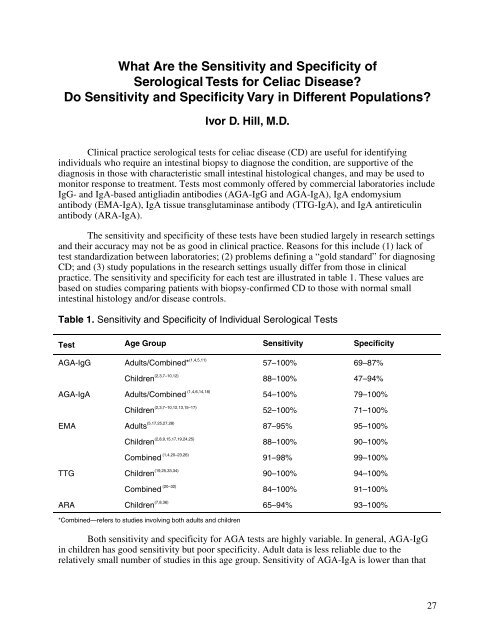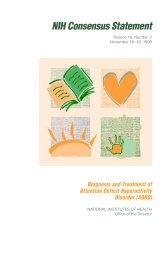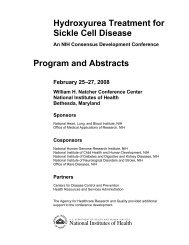Celiac Disease - NIH Consensus Development Program - National ...
Celiac Disease - NIH Consensus Development Program - National ...
Celiac Disease - NIH Consensus Development Program - National ...
You also want an ePaper? Increase the reach of your titles
YUMPU automatically turns print PDFs into web optimized ePapers that Google loves.
What Are the Sensitivity and Specificity ofSerological Tests for <strong>Celiac</strong> <strong>Disease</strong>? Do Sensitivity and Specificity Vary in Different Populations? Ivor D. Hill, M.D.Clinical practice serological tests for celiac disease (CD) are useful for identifyingindividuals who require an intestinal biopsy to diagnose the condition, are supportive of thediagnosis in those with characteristic small intestinal histological changes, and may be used tomonitor response to treatment. Tests most commonly offered by commercial laboratories includeIgG- and IgA-based antigliadin antibodies (AGA-IgG and AGA-IgA), IgA endomysiumantibody (EMA-IgA), IgA tissue transglutaminase antibody (TTG-IgA), and IgA antireticulinantibody (ARA-IgA).The sensitivity and specificity of these tests have been studied largely in research settingsand their accuracy may not be as good in clinical practice. Reasons for this include (1) lack oftest standardization between laboratories; (2) problems defining a “gold standard” for diagnosingCD; and (3) study populations in the research settings usually differ from those in clinicalpractice. The sensitivity and specificity for each test are illustrated in table 1. These values arebased on studies comparing patients with biopsy-confirmed CD to those with normal smallintestinal histology and/or disease controls.Table 1. Sensitivity and Specificity of Individual Serological TestsTest Age Group Sensitivity SpecificityAGA-IgG Adults/Combined* (1,4,5,11)57–100%Children (2,3,7–10,12) 88–100%AGA-IgA Adults/Combined (1,4,6,14,18)54–100%Children (2,3,7–10,12,13,15–17) 52–100%69–87%47–94%79–100%71–100%EMA Adults (5,17,25,27,28) 87–95% 95–100%Children (2,8,9,15,17,19,24,25) 88–100% 90–100%Combined (1,4,20–23,26) 91–98% 99–100%TTG Children (19,25,33,34) 90–100% 94–100%Combined (20–32) 84–100% 91–100%ARA Children (7,8,36) 65–94% 93–100%*Combined—refers to studies involving both adults and childrenBoth sensitivity and specificity for AGA tests are highly variable. In general, AGA-IgGin children has good sensitivity but poor specificity. Adult data is less reliable due to therelatively small number of studies in this age group. Sensitivity of AGA-IgA is lower than that27







